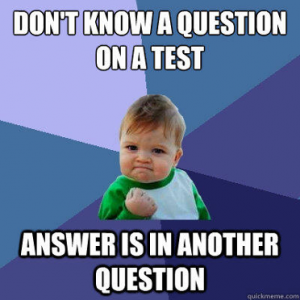7 Textual Circulation
Christian J. Pulver, PhD
As citizens in the twenty-first century, we live in a networked world where texts and media of all kinds circulate quickly across the internet and the larger public. To think about how texts circulate in culture is to consider how they get written, how they get shared, and how the meanings they carry move with them as they travel from context to context. These days such texts often include images, sound, and video, as well as words (for example, multimodal texts), and as the internet grows and expands, the circulation of texts, genres, and meaning all speed up, changing our writing and rhetorical practices in the process.
There are many ways to think about how texts circulate, from the posts we share online, to the memos we exchange at work, to the larger world of the public internet where texts and information circulate globally. Traditional print newspapers and magazines have long tracked their circulation and subscribers. However, in the digital spaces of the global internet, our experience of how writing and rhetoric move has radically changed, not only in how we write and communicate with friends and family, but also in the ways ideas flow through cultures and give shape to professional and public discourse about problems that matter.
To illustrate how textual circulation works, let’s look at a quick example of a genre that exemplifies how texts circulate in modern writing environments: memes. The term, coined by evolutionary biologist Richard Dawkins, is a play on the word gene. Analogous to genes, memes are ideas that replicate and spread through human culture as people encounter and share them. Memes may be exchanged by two people, as when a teacher explains a new concept to a student, or on a larger, societal scale when big ideas like liberty or social justice take shape over generations of people.
Modern internet memes may not always be about something as lofty as a concept like liberty, but they move and morph from person to person like any other meme. Nowadays, memes come in many forms and genres, but one of the most common kinds is what is known as the “advice animal image macro”—as seen in Image 1. Most of us are familiar with this kind of meme. Advice animal image macros like “success kid” are common memes that use the same image but add a different phrase at the top and bottom of the image. In the case of “success kid,” the top phrase states a problem (“Get sick on Friday”), and the bottom phrase states a serendipitous outcome (“Three day weekend”).

Like all memes, “success kid” has a history of development and circulation. The original image was taken in 2007 by Lindey Griner of her 11-month-old son Sammy and posted to Flickr to share with family (Image 2). The “I hate sandcastles” image was the first image meme to be circulated that used the little boy’s image (Image 3). Others soon picked up on the 2007 image and began altering it for their own rhetorical purposes. By 2008, the image was used by dozens of other people to convey either a sense of frustration, as in “I hate sandcastles,” or a feeling of unexpected success, giving birth to the now well-known “success kid” meme (Images 4 and 5).
 |
 |
 |
 |
Today, thousands of image macros have been spun from this original image, and “success kid” memes continue to circulate online as other meme creators draw on the shared meaning of the meme in new contexts. Thus, when considering textual circulation, we are looking at how texts get composed, how they reference and borrow meaning from each other, where they go, and the meanings they carry as they circulate.
For writers researching and studying a particular problem in the public realm, understanding how texts circulate, and how to trace this circulation, can give us a better sense of the larger discourse that shapes the issue or problem we’re researching. For example, in writing this entry on textual circulation, I started with a basic online search for the issue I was going to write about: “memes and circulation.” One of the first results to catch my attention was an article by Angela Volpe from the online tech magazine The Verge, “It’s Not All Pepes and Trollfaces—Memes can be a Force for Good.” Written in 2018, the article explores how memes act as “emotional contagion” as they circulate in public and across social media (Image 6).
Finding a good entry text into the problem you are considering is a useful way to start tracing some of the other texts and voices that are currently circulating around an issue. Using Volpe’s as my entry text into the problem of memes in public discourse, I looked closely at the texts and sources the author incorporated into the article.
In all, Volpe quotes and cites over ten different sources in the article, drawing on a range of texts and genres: an article from The Guardian newspaper; a study by the European Union on the influence of memes in fringe communities; a popular website on memes known as knowyourmeme.com; and a book by psychology professor John Suler, Psychology of the Digital Age, about the social and mental health issues related to online communication. Image 6 illustrates how Volpe’s article served as a good entry point to the problem I was exploring because it connected to several other texts circulating around the same issue.

As is often the case when tracing how texts and ideas circulate, you’ll come across several kinds of texts, from popular to scholarly articles, books, websites, and video. By doing this preliminary tracing of some of the texts circulating around the problem you are exploring, you’ll begin to develop a more detailed understanding of the problem and how others are thinking about it, as well as the shape and extent of the conversation. Knowing this context and the ways texts circulate around an issue will also help you as a writer understand how you might effectively enter this conversation, depending on your audiences and purposes.
External and Internally Circulating Texts within Groups or Organizations
Of course, texts circulate both online and offline, so understanding how they circulate at a more local level—in your discourse communities at home, school, and work—is another important facet of textual circulation. If the problem you are studying is related to a particular community or organization, you’ll want to understand what kinds of texts are being shared and circulated in this context. What kinds of genres are circulating? How is writing being shared and for what purpose? What texts are being circulated to the public, and what types are used internally?
For the internal circulation of a group or organization, the activity of writing plays a vital role in how any particular discourse community—a business, a committee, a team—approaches a problem and how well they work together. Emails, memos, shared documentation, reports, agendas, and minutes are common genres that circulate widely through professional settings where writing and documents are being produced. If you are studying a particular community or organization, understanding how texts circulate and what kinds of texts are exchanged will help you make sense of how this group or organization shares ideas, works together, handles disputes, etc. And by mapping this out, you can create a bird’s eye view of how a group or organization is communicating internally, what’s working well, and what practices could be improved to help the group function better.
Circulating Writing in Collaborative Teams
You’ll also want to keep textual circulation in mind when you are collaborating with a team of writers. What is the document flow like for the group? How is the team managing information and shared resources? Is the group working with shared documents, circulating drafts via email or by hand? Are the documents moving as they should and getting to readers and reviewers when they need to?
While humans have long thought about how texts circulate in our digital and collaborative environments, understanding how texts spread and move from person to person should be a part of every writer’s toolbox. As a practical research strategy for understanding the context of a problem, having a sense of what texts and meanings circulate around the problem will help you see the potential ways it might be addressed.
Work Cited
Dawkins, Richard. The Selfish Gene. Oxford University Press, 1976.
Media Attributions
- Get Sick on Friday
- Baby on Beach
- I Hate Sandcastles Meme
- Success Kid Meme 2
- Success Kid Meme 3
- Textual Circulation Infographic © Christian Pulver

